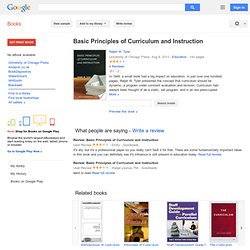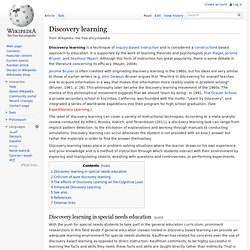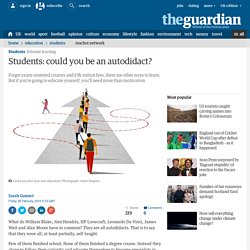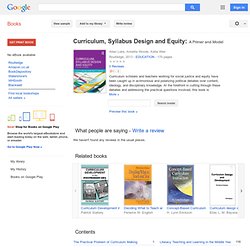

Curriculum Design in a Changing Society. Basic Principles of Curriculum and Instruction - Ralph W. Tyler. In 1949, a small book had a big impact on education.

In just over one hundred pages, Ralph W. Tyler presented the concept that curriculum should be dynamic, a program under constant evaluation and revision. Curriculum had always been thought of as a static, set program, and in an era preoccupied with student testing, he offered the innovative idea that teachers and administrators should spend as much time evaluating their plans as they do assessing their students.
Since then, Basic Principles of Curriculum and Instruction has been a standard reference for anyone working with curriculum development. Although not a strict how-to guide, the book shows how educators can critically approach curriculum planning, studying progress and retooling when needed. Key Concepts for Understanding Curriculum - Colin J. Marsh. Key Concepts for Understanding Curriculum is an invaluable guide for all involved in curriculum matters.

Now fully updated, this revised and enlarged fourth edition provides not only a solid grounding in the subject but also covers the latest trends and issues affecting the field. Written in Marsh's clear and accessible style, the book details the strengths, weaknesses and controversies around major concepts in curriculum, including. Key Concepts for Understanding Curriculum - Colin J. Marsh. Stenhouse process model. Higher Education and Sustainable Development: A Model for Curriculum Renewal - Cheryl Desha, Karlson 'Charlie' Hargroves. Curriculum according to Stenhouse - SpeedyLook encyclopedia.
Stenhouse proposes a model of Investigation and Development of the Curriculum. curriculum is a powerful and immediate instrument for the transformation of education, because she is one fecund guide for the professor.

Stenhouse affirms that the pedagogical ideas appear like more important for the personal and professional identity of the professor who like something useful for its practical activity. This premise explains the separation between theory and practice, and investigation and action. So that the curriculum is the transforming element, it must have another form and a process of elaboration and different implementation. Discovery learning. Jerome Bruner is often credited with originating discovery learning in the 1960s, but his ideas are very similar to those of earlier writers (e.g.

John Dewey). Bruner argues that "Practice in discovering for oneself teaches one to acquire information in a way that makes that information more readily viable in problem solving" (Bruner, 1961, p. 26). This philosophy later became the discovery learning movement of the 1960s. The mantra of this philosophical movement suggests that we should 'learn by doing'. DISCOVERY LEARNING. Discovery Learning at UT is promulgated primarily by the College of Natural Sciences but I first encountered it in an English course, the Freshman English sequence at Amherst College taught from 1938 to 1966.

That course in turn influenced the Natural Sciences, particularly the two-semester Physics course required of all Freshmen. As you can see in the course description the emphasis on discovery learning was extraordinary. Active learning is also the centerpiece of the famousBoyer Blueprint for Reinventing Undergraduate Education Discovery learning is known as active learning because you participate actively in the learning process rather than passively receiving knowledge as if you are an empty vessel to be filled by the instructor. Active learning supports the belief that knowledge can be constructed by you rather than received from a higher authority.
Discovery learning also has the following benefits: Students: could you be an autodidact? What do William Blake, Jimi Hendrix, HP Lovecraft, Leonardo Da Vinci, James Watt and Alan Moore have in common?

They are all autodidacts. That is to say that they were all, at least partially, self-taught. Few of them finished school. None of them finished a degree course. Instead they chose to follow their curiosity and educate themselves to become specialists in their respective areas. Today, students are surrounded with pressure to focus on qualifications, rather than exploring their interests. Exams no longer do their job of testing what a student has learned during their course; instead they've become the main focus of the programme. But what if students took control and decided how their education was structured? For the £9,000 it costs to receive a year's worth of university tuition, a student could instead buy a library of 3,214 books (at the standard Amazon Marketplace price of £2.81).
Process model. Curriculum Studies in Post-compulsory and Adult Education: A Study Guide for ... - Mary Neary. Content Model. Curriculum, Syllabus Design and Equity: A Primer and Model. Curriculum scholars and teachers working for social justice and equity have been caught up in acrimonious and polarizing political debates over content, ideology, and disciplinary knowledge.

At the forefront in cutting through these debates and addressing the practical questions involved, this book is distinctive in looking to the technical form of the curriculum rather than its content for solutions. The editors and contributors, all leading international scholars, advance a unified, principled approach to the design of curriculum and syllabus documents that aims for high quality/high equity educational outcomes and enhances teacher professionalism with appropriate system prescription.
Key Concepts for Understanding Curriculum - Colin J. Marsh. Curriculum Studies: Curriculum knowledge. Understanding Curriculum: An Introduction to the Study of Historical and ... Curriculum Design in a Changing Society.